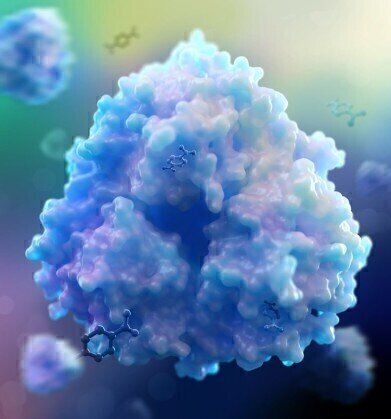-
 JProfessor John McGeehan, Director of the University’s Centre for Enzyme Innovation. (Credit: University of Portsmouth)
JProfessor John McGeehan, Director of the University’s Centre for Enzyme Innovation. (Credit: University of Portsmouth) -
 The TPADO enzyme(. Credit: Rita Clare, Montana State University)
The TPADO enzyme(. Credit: Rita Clare, Montana State University)
News
Enzyme Discovery increases Scope for breaking down Plastics
Mar 25 2022
As part of the UK/US Bottle Consortium project to tackle plastic recycling and upcycling, scientists have used Diamond’s macromolecular crystallography (MX) beamline I03 to characterise an enzyme capable of breaking down terephthalate (TPA), one of the chemical building blocks of polyethylene terephthalate (PET) plastic, widely used in-single use items such as drinks bottles.
The research(1), was co-led by Professor Jen DuBois, Montana State Universit, and Professor John McGeehan from the University of Portsmouth, who in 2018 led the international team that engineered a natural enzyme that could break down PET plastic drinks bottles, clothing and carpets.
The enzymes (PETase and MHETase) break the PET polymer into the chemical building blocks ethylene glycol (EG) and TPA.
“While EG is a chemical with many uses – it’s part of the antifreeze you put into your car, for example – TPA does not have many uses outside of PET, nor is it something that most bacteria can even digest,” said lead author Professor DuBois from Montana State University. “However, the Portsmouth team revealed that an enzyme from PET-consuming bacteria recognises TPA like a hand in a glove. Our group at MSU then demonstrated that this enzyme, called TPADO, breaks down TPA and pretty much only TPA, with amazing efficiency.”
Lead author and experienced Diamond user Professor McGeehan, who is the Director of the University of Portsmouth’s Centre for Enzyme Innovation, said: “The last few years have seen incredible advances in the engineering of enzymes to break down PET plastic into its building blocks. This work goes a stage further and looks at the first enzyme in a cascade that can deconstruct those building blocks into simpler molecules. These can then be utilised by bacteria to generate sustainable chemicals and materials, essential making valuable products out of plastic waste.
“Using powerful X-rays at Diamond Light Source, we were able to generate a detailed 3D structure of the TPADO enzyme, revealing how it performs this crucial reaction. This provides researchers with a blueprint for engineering faster and more efficient versions of this complex enzyme.”
With more than 400 million tons of plastic waste produced each year, the overwhelming majority of which ends up in landfills, it is hoped this work will open the door to improve bacterial enzymes, such as TPADO. This will help tackle the challenge of plastic pollution and develop biological systems that can convert waste plastic into valuable products.
(1) Kincannon W.M. et al. Biochemical and structural characterization of anaromatic ring–hydroxylating dioxygenase for terephthalicacid catabolism. PNAS (2002). DOI: 10.1073/pnas.2121426
More information online
Digital Edition
Lab Asia Dec 2025
December 2025
Chromatography Articles- Cutting-edge sample preparation tools help laboratories to stay ahead of the curveMass Spectrometry & Spectroscopy Articles- Unlocking the complexity of metabolomics: Pushi...
View all digital editions
Events
Jan 21 2026 Tokyo, Japan
Jan 28 2026 Tokyo, Japan
Jan 29 2026 New Delhi, India
Feb 07 2026 Boston, MA, USA
Asia Pharma Expo/Asia Lab Expo
Feb 12 2026 Dhaka, Bangladesh


















